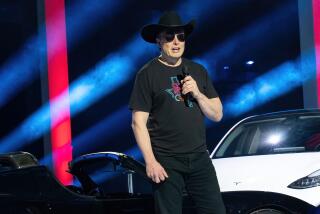Plugging Parts for Plug-In Cars : Manufacturing: The Burbank-based Calstart consortium envisions California as a âSilicon Valleyâ for electric vehicle components.
The shuttering of the General Motors plant in Van Nuys last summer brought an end to the era of auto manufacturing in Southern California. It was an added blow to a Southland economy that has lost more than 100,000 jobs over the past several years from defense and aerospace layoffs.
But as the GM plant shut its doors, another enterprise was quietly revving up a few miles away in Burbank. Calstart, a nonprofit consortium, was officially launched in June to foster the creation of a statewide electric vehicle components industry. Among its participants and sponsors are GM, IBM, Lockheed Corp., the state of California, UCLA, Southern California Edison and Lawrence Livermore National Laboratory.
With $20 million--including $14 million in member donations, $4 million in federal funds and $2 million in state money--Calstart hopes to tap technology from Californiaâs aerospace industry, and transfer it to the development of electric vehicle parts. The hope is that U.S. and foreign auto makers will buy these parts from local firms. Calstart predicts that 55,000 jobs can be generated by this effort by the year 2000.
A pipe dream? Not according to Lon Bell, Calstartâs founding president, who believes that the electric car industry equivalent of Silicon Valley is possible in California. âIf we have the will to make the transition, we can and will be successful,â Bell declared.
Itâs a worthy goal, but Calstart faces a daunting task.
Industry insiders warn that enormous technological impediments remain, particularly with electric car batteries, which are widely seen as too heavy, costly and underpowered. Most auto makers admit they are a long way from making electric cars competitive with gas-powered vehicles.
Even when an electric car industry does emerge, thereâs no guarantee that manufacturers will turn to California for components. Most car companies say itâs too early to decide where they will buy electric vehicle components, much less where they will build the cars.
That electric cars will be sold in California is not in question. The state has strict air-quality regulations that require car companies selling here to produce 40,000 electric cars for the California market each year beginning in 1998, and 200,000 by 2003. (About 2 million new vehicles are sold a year in California.)
Virtually all the major auto makers--not wanting to lose a slice of the important California market--are scrambling to meet the 1998 target.
Calstartâs efforts will help California share in any future growth in the electric car industry, observers say. But they argue that much more needs to be done.
âThe biggest obstacle is creating a political climate to make this happen,â said Rep. Howard L. Berman (D-Panorama City). Berman authored an amendment to federal transportation laws, under which Calstart received the $4 million in federal funds. Like many others, Berman argues that local and state officials must be aggressive in attracting auto makers here--particularly given Californiaâs reputation as being inhospitable toward business.
Allen Scott, director of UCLAâs Lewis Center for Regional Policy Studies--which produced a report on alternative-fuel vehicles that helped inspire the formation of Calstart--said the consortium is a good first step. But a bigger benefit to the local economy would come if car companies were to produce electric vehicles here, he said.
âCalstart is one part of the puzzle,â Scott said. âBut there are other parts of the puzzle that need attention.â
Calstart hopes to make a big splash when its electric car model debuts at the Los Angeles Auto Show in January. This âshowcaseâ car is not a prototype for a future production vehicle. Rather, itâs intended to show off California-bred technology and products to the future producers of electric cars.
The Calstart car includes a navigation system that responds to the human voice, a crash-safety system that uses the weight of the carâs battery pack to inflate air bags and tighten seat belts, an aerodynamic underbody structure and lightweight tires that boost mileage.
All the components on the vehicle were made by Calstart members. Trojan Battery Co. in Santa Fe Springs developed the battery; ITT Cannon in Santa Ana, a unit of ITT Corp., created a fiber-optics wiring system; Hughes Power Control Systems in Torrance, part of GMâs Hughes Aircraft subsidiary, built the recharging system, and Kaiser Aluminum & Chemical in Vernon made the frame.
Calstart is also working with GM and local utilities on creating an infrastructure for recharging and recycling electric car batteries and servicing the cars. Other programs include an electric bus project, the development of a golf-cart-sized vehicle for short trips, product testing, and retraining programs for aerospace workers.
GM is expected to be the first to mass-produce an electric car--a two-seat sports car based on GMâs Impact prototype--that is scheduled to be sold in California in the mid-1990s.
The Impact will be built in Michigan, but Calstart officials take heart from the fact that much of the Impact was developed in California, at Hughes Power Control Systems and GMâs Advanced Concepts Center in Thousand Oaks. Like GM, most auto companies already have design centers in Southern California.
Some small companies are also hoping to compete in the fledgling industry, including Nordskog Electric Vehicles in Redlands, which makes electric shuttles, and Solar Electric Engineering Inc. in Santa Rosa, which converts conventional cars to electric power and soon plans to introduce an electric vehicle made from scratch.
Bell believes California could also get an edge in the components business because roughly 70% of an electric car will consist of parts entirely new to the auto industry. So, rather than turning to traditional suppliers or producing parts themselves, he thinks car makers will use new sources of supply. Californiaâs high-tech companies are obvious choices, he contends.
Some auto makers say that Calstartâs efforts could influence their sourcing decisions. After meeting with Calstart recently, Karl Heinz Ziwica, an environmental engineer at BMW of North America Inc., said that the consortium members âmight have an edge with certain technologies.â
Larry Nutson, a spokesman for Volkswagen of America Inc., said that California companies might have an advantage should VW decide to produce its electric cars--now in development in Europe--at its Mexico plant. âA California company would have the opportunity to have a better handle on what the U.S. consumer is looking for,â he said.
But Kelly Brown, an executive engineer at Ford Motor Co., said that Fordâs domestic production of electric vehicles will almost certainly be located at an auto plant in the Midwest. And because Ford prefers to keep inventories lean to reduce costs, âitâs best to have suppliers as close as possible,â he said.
Calstart could also have some competition from other states that have begun assembling rival efforts. Brown said that Ford has been courted by Massachusetts, which boasts features similar to California--a high-tech industry, top universities and empty auto plants. A Maryland consortium and a New York group have also received federal grants.
Still, many share Bellâs hope.
Michael Gage, president of the Los Angeles Department of Water & Powerâs board of commissioners, called Bell a âvisionary.â Gage recently replaced Bell as president of Calstart, but Bell remains deeply involved in the consortium.
Ron Cogan, features editor at Motor Trend magazine, noted that Bellâs former company, Technar, successfully converted aerospace technology into air-bag sensors, eventually capturing more than 50% of the global air-bag sensor market. Bell, 52, sold Technar to TRW in 1986, and ran the company until 1991. âHe has quite a bit of credibility coming in,â Cogan said.
When Bell retired from TRW he started Amerigon, a Burbank company that develops advanced vehicle components, and shortly after he helped found Calstart. In June, Calstart moved into a 155,000-square-foot plant provided rent-free for two years by Lockheed. The cavernous building is mostly empty now, with just 50 workers there. Within about a year, Calstart plans to have more than 1,000 employees, and by 1994 Bell expects to have another $20 million in funding secured.
Bell acknowledges that shifting California away from bombs and missiles and into electric cars wonât be easy, but heâs optimistic. âItâs not a matter of will it happen,â he said, âitâs a matter of the degree that it happens. Itâs our job to make that degree as large as possible.â
More to Read
Inside the business of entertainment
The Wide Shot brings you news, analysis and insights on everything from streaming wars to production â and what it all means for the future.
You may occasionally receive promotional content from the Los Angeles Times.








